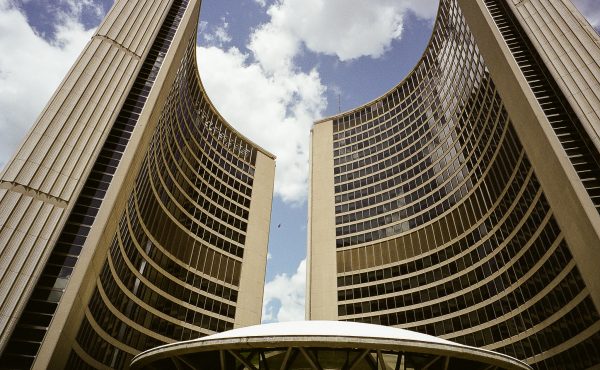
This is just a quick “did you know?” post. The Ontario Ministry of Transportation has a policy that requires 93% of provincial residents to live within 10 kilometres of a highway, but it doesn’t have a policy or goal to get Ontarians to live within a walkable community. The government touts how proud they are at spending over $1-billion a year on highway upkeep and construction, but never once states that it could reduce those costs if they encouraged residents to drive less by living in more pedestrian-friendly communities. I recognize the important role highways play within our economy, but I’m always frustrated how little attention (and money) is dedicated towards helping municipalities establish vibrant, walkable neighbourhoods. The government’s Places To Grow plan is fine, but it only addresses where sprawl can happen and doesn’t provide enough information on how to build the right type of developments.
A popular litmus test for a walkable community, developed by Dan Burden of Walkable Communities, is called the Popsicle Test: in every neighbourhood there must be some destination worth walking to, close enough that if you walk there to get a popsicle, you could walk there in comfort and walk back without it melting. Since Burden lives in sunny Florida, the test is quite a stringent one.
If you’re interested in a local take on walkable communities, you should read the article by Spacing editor Dylan Reid from the Everyone is a Pedestrian, Summer 2004 issue.
photo by Adam Krawesky




18 comments
The problem with walkable communities is convincing people to actually do some walking.
I live downtown and suggested to my Mississauga-resident brother came over for a visit. i suggested we walk four blocks for a slice of pizza and he thought I was crazy not to drive that distance. Seriously!! Four f*@%in’ blocks. I made us walk and he spent the whole six minutes of the hike bitching.
Once people get used to a certain car-based convenience, it’s a hard habit to break.
Funny that the provincial government has a policy of having over 93 percent of the population living within 10km of a provincial highway corridor, but in 1997 and 1998, the province downloaded almost half of its highways to cities, towns and counties! Or that the highway that may have remained in the network doesn’t get you where you need to go.
In a way, this is a really stupid goal/statistic.
Gary C makes a good point (2 comments above) – not only does auto-based development make it unable for people to do anything in the absence of a car, but it makes them believe that a car is necessary to do anything, no matter where you are.
I have friends and relatives who think just like Gary’s brother, and it’s sad that they’ve been brainwashed to think the car is the only way to go, even when in downtown Toronto.
I am curious if the Ministry of “Transportation” has a policy of x percent of the population being within, say, 10 minutes of reliable transit.
I was also struck the other day about the extensive number of highways that have been built in the past decade or that are planning to be built versus the pathetic transit building Toronto has seen in the same time frame, for example, just the stump of a subway to Fairview Mall.
You’re quoting the MTO “Business Plan 2002-2003”, i.e. under the old Conservative government. The 10 km “policy” isn’t mentioned in a more recent plan, which does set goals for increasing transit ridership.
That said, the Liberals have funded some pretty big highway projects, so the highway mentality remains and the 93% level is probably still being met.
It seems like some suburban municipalities are starting to understand walkability (Markham has some good newer developments) while others clearly still don’t. It’s a tricky balance between ensuring province-wide standards and emphasizing local planning.
Gary hit it right on the nose.
Most of my family lives in Brampton, and they drive EVERYWHERE.
They balk when I walk 30 minutes to the local mall. Walking is taboo to them.
the more suburban areas and the province are even more “carrupt” than the city of Toronto, and it’s not always by choice, and it’s not design either, it’s a long-practiced set of policies and levers that sell out nature and future generations.
Surely if the extra ten pounds on people, higher rates of complications due to that, enervating life in the suburbs, and gas over a dollar has not convinced people to change, nothing will.
Gary and Justin, can I guess that your families in the suburbs, like mine, are in far worse health than you are: both physically and psychologically?
Gary> Yep. I think back to assumptions i used to make living in Windsor, about what was walkable (and I even liked to walk). So many places/distances I’d not conceive of walking to.
At my exurban homestead, we would sometimes walk to the Highway where the Sunoco gas station was and buy popsicles, and eat them on the way back. So, uh, we fit into the walkability test, and the Ontario standards test.
There is typically a guideline of 400 metres to transit service, but that doesn’t specify what level of transit service (e.g. 30-minute headways and service that ends at 7 in the evening?).
I visited a friend of a friend two weeks ago at her townhouse in Etobicoke.
I found out that she drives to Kipling Subway station and parks in the Metropass holders lot.
It is less than a 5 minute walk, less than a 1 km to either Kipling or Islington station from her front door.
I was and I am still shocked that she does this and that she complains about having gained 18 pounds since she moved out to Etobicoke….
It will take a lot of work to get most people moving and thinking rationally!
I totally want a popsicle now.
It’s hard to take pleasure in walking around in a city when what you see is just so ugly!! And TORONTO IS A REALLY UGLY CITY!! What you see everywhere in Toronto is concrete, greyness, few green spaces, ugly neglected buildings, no landscaping, and hydro wires hanging over your head. It is just so UGLY!!!
I lived in Manhattan for years and absolutely LOVED walking around the city. There are beautiful parks and parkettes everywhere, buildings have landscaping in front of them (shrubs, plants, flowers), the architecture is fantastic, and there is a vibrant street life everywhere.
But Toronto, good Lord it’s depressing to walk around this city. I’d rather just get in my car, drive quickly through the ugliness and get to my final destination!
It would also help if there were pedestrian-only neighbourhoods in Toronto – most European cities have pedestrian neighbourhoods. Why can’t we turn a few streets in Yorkville into pedestrian-only streets, or make Yonge south of Bloor into a cobblestone pedestrian-only street?
It’s being done extremely successfully all over the world — why can’t Toronto see that this would make the city a much better and more liveable place.
This city is not only ugly Jonathan, but it is also noisy (cars), and uninteresting. But you, Jonathan, were spoilt by living in a real city: Manhattan. I was spoilt by living in a real city: Tokyo. Wish more Torontonians dared to aim higher by comparing our city to cities that do not need to get called “world class” by their mayors.
???
Shawn, it’s a question of protesting too much.
This site really needs to be corrected, reflecting Matt L’s point that you’re quoting the policies of previous government that are no longer the law or goals of the administration.
It’s totally misrepresenting provincial policy, which happens to be pretty progressive on these issues.